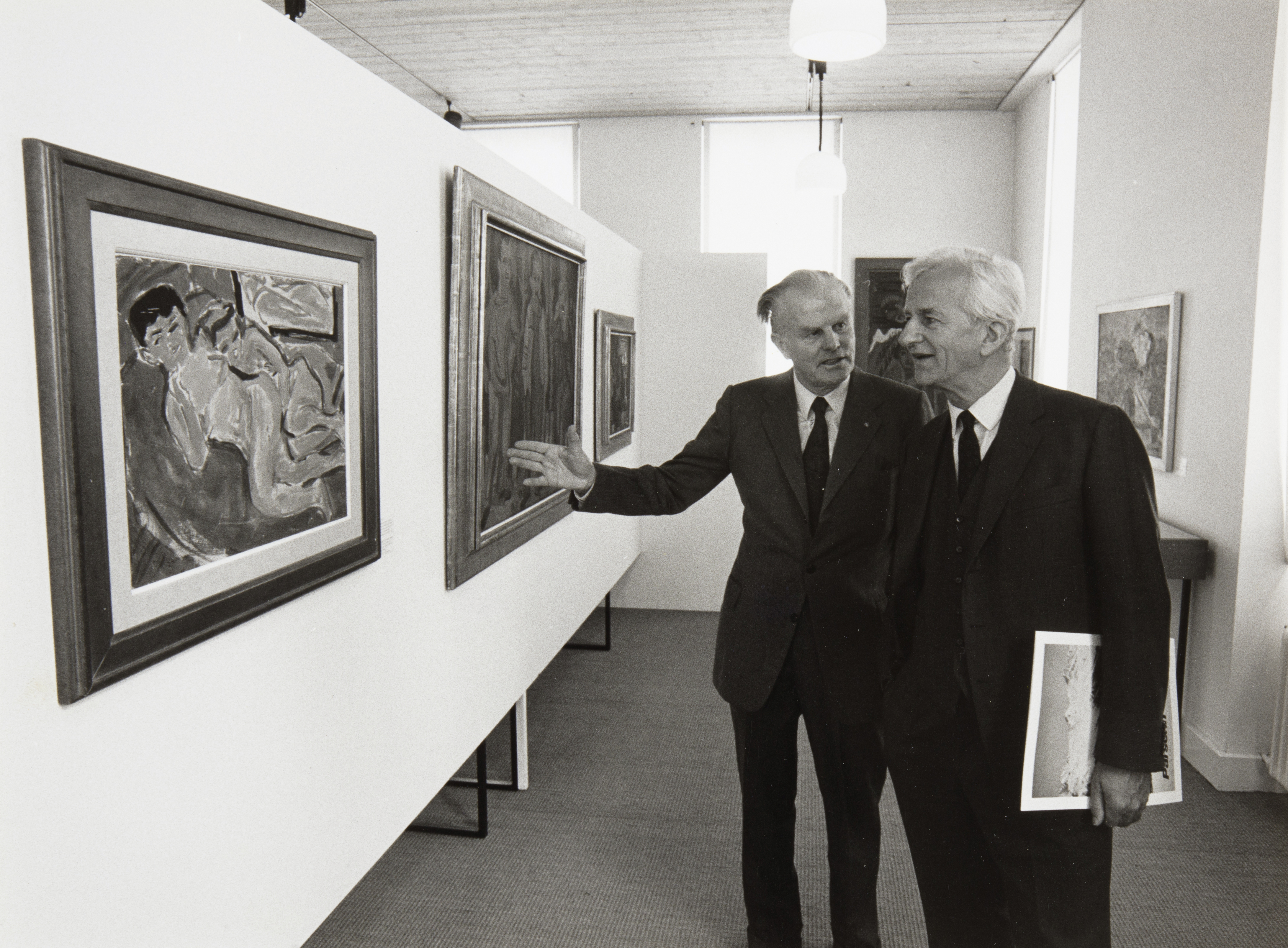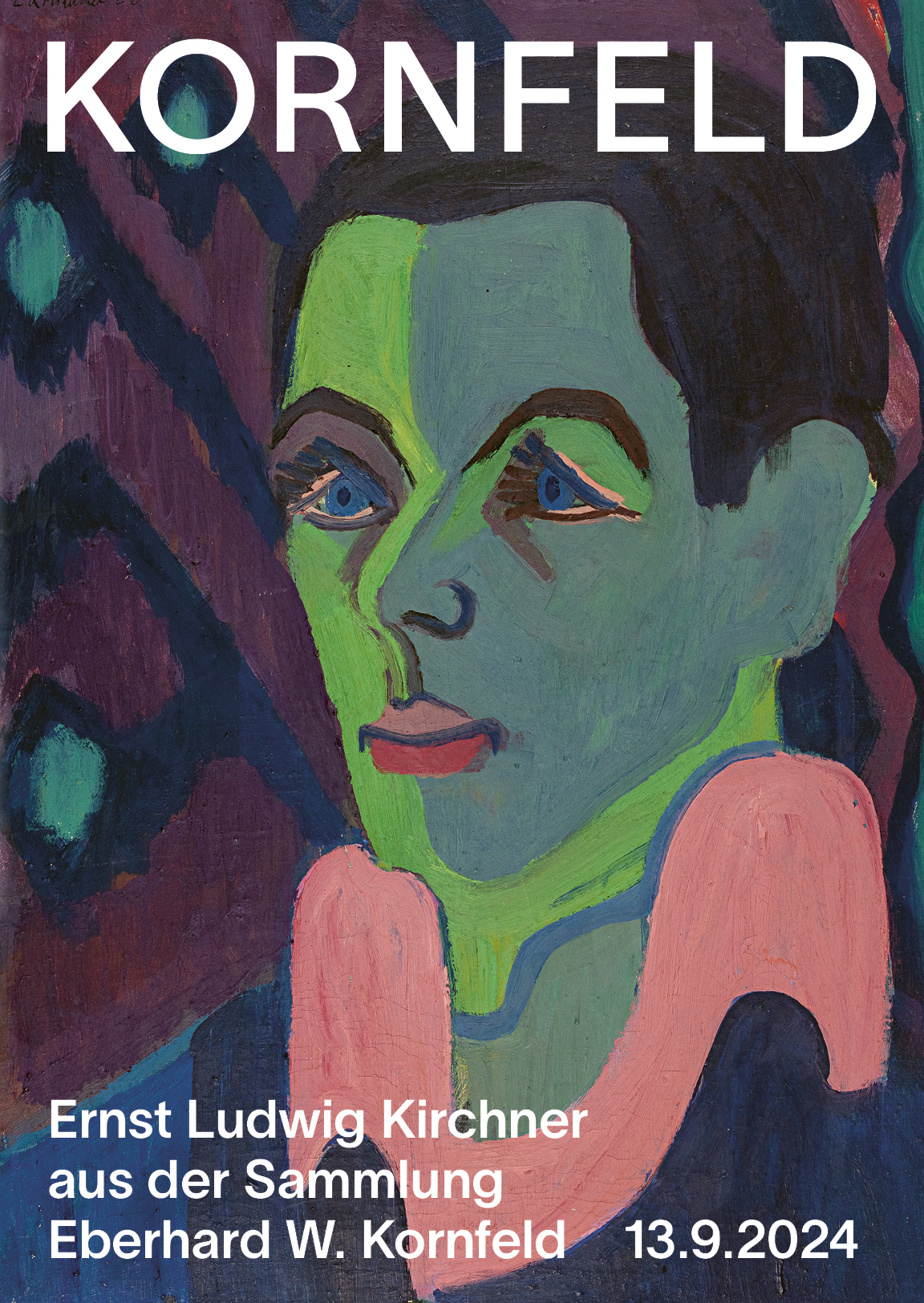- EN
Log in
- Live Auctions
- Past auctions
- More
- Gallery
- Art Dealing
- Publishing
- Kornfeld today
- The Story of Kornfeld
- Information

Kornfeld was introduced to Ernst Ludwig Kirchner’s works early on in his career, as his teacher and mentor, Dr August Klipstein, often exhibited works by the expressionists in his gallery in Bern. In 1933, for example, he exhibited Kirchner’s prints in his rooms at Amthausgasse 16 as part of the major Kirchner show at the Kunsthalle Bern. Kornfeld, who had been an intern with Klipstein since 1945, was deeply impressed by Kirchner’s art.
In particular, the presentation of selected works in the exhibition ‘Paula Modersohn und die Maler der Brücke’ at the Kunsthalle Bern in 1948 made a lasting impression on him and awakened his interest in Kirchner and the Brücke artists. The works on display came from the mysterious ‘Gervais, Zurich/Lyon’ collection, which Kornfeld later exposed as a phantom. It was in fact Kirchner’s last student, Christian Laely, who was behind it. Laely, who organised Kirchner’s estate, had works from it exhibited and sold under the collector's pseudonym ‘Gervais, Zurich/Lyon’ (cf. lots 66, 79, 84).
Kornfeld said of Kirchner that he never wanted to meet him in person, because he must have been a very difficult and irascible person. Had he met him, he might never have felt the same fascination for this unique artist and his work. Kornfeld, who was trained in old master prints, thought that Kirchner could be described as a kindred spirit to Dürer or Rembrandt: Kirchner also saw prints not simply as a means of reproduction, but as an independent and innovative artistic form. Experimenting with printing blocks or copper plates made it possible to create entirely new works, and it is not surprising that Kornfeld, alongside the pioneers of printmaking Goya, Degas, Gaugin and Munch, also held Kirchner in high esteem. Kirchner’s very small editions were bound to interest a print enthusiast like Kornfeld. He was impressed by the different states of the prints and by Kirchner’s efforts to develop the motif.
Examples of this are the two woodcuts ‘Frau in der Nacht – Portrait Frau Dr. Robert Binswanger, Kreuzlingen’ (lot 80 and 81) in this catalogue, of which Kornfeld owned the first state, printed in black, and the second, printed in colour. Kornfeld was also interested in collecting sketches or preparatory works in order to obtain as complete a picture of a work as possible. He began by acquiring Kirchner’s prints and drawings, later adding watercolours, oil paintings, sculptures and everyday objects (such as Kirchner’s coffee grinder, his last painting tools or his monogram stamp, lot 89).

Equally important to Kornfeld were documents relating to Kirchner, such as letters, information on the Brücke or rare catalogues, as well as Kirchner’s dwellings. Kornfeld’s financial support made it possible to renovate and preserve the mountain huts on the Stafelalp, where Kirchner spent the summers of 1918–1920, and to acquire Kirchner’s studio houses in Davos: the Wildboden house at the entrance to the Sertig valley, where the artist lived and worked until his death in 1938, in the early 1960s, and in 1982 the house ‘In den Lärchen’, where Kirchner lived until the autumn of 1923.
In order to preserve the houses as Kirchner sites, Kornfeld opened the Wildboden house as a private museum with parts of his Kirchner collection every August since 1964. These presentations gave rise to the idea of a Kirchner museum, and Kornfeld was instrumental in setting up the first permanent Kirchner museum in the old post office building in Davos Platz in 1982. Kornfeld is also regarded as the museum’s first curator: during the first ten years, he organised numerous exhibitions, often using his own collection.

Kornfeld was undoubtedly one of the leading authorities on Kirchner. His monographic magnum opus on Kirchner is still regarded as a standard work today, and the ‘Acht Aufsätze zu Ernst Ludwig Kirchner’ (eight essays on Ernst Ludwig Kirchner), published just two years before his death, are an impressive conclusion to his decades-long engagement with the artist. Also worth mentioning are publications on Kirchner’s houses and his textile works. Kornfeld probably owned one the largest collections of Kirchner’s prints. It is therefore not surprising that Günther Gercken’s seven-volume catalogue raisonné of Kirchner’s prints was published by Kornfeld (2013–2021).
As an art dealer, Kornfeld also played an important role in promoting Kirchner’s art. Not only did countless works pass through his hands during his long career, but he was also the custodian of ‘historical’ Kirchner collections for generations. He was also always on the lookout for new sources on Kirchner. Knowing, for example, that many of Kirchner's treasures were still to be found in Davos, Kornfeld visited the local farmers and craftsmen. All of them had received one of Kirchner’s works at one time or another, either as payment for their services or as a gift, and he rediscovered these prints, some of them rolled up, in drawers and cupboards. From 1940, the artist and weaver Lise Gujer (1893–1967) lived in the ‘Gruoba’ house in the Sertig valley. A close friend of Ernst Ludwig and Erna Kirchner, she realised some of Kirchner’s works as tapestries. Later, she acquired furniture and works of art for her home from the Kirchner estate and was an important source of information for Kornfeld in the Davos area for many years. Works from her estate were sold at a special auction at Kornfeld and Klipstein on 15 June 1968.

In over 70 years Kornfeld created one of the most extensive Kirchner collections. Some important donations went to museums, for example the carved bed for Erna to the Kirchner Museum Davos, the painting ‘Rückkehr der Tiere’ from 1919 to the Kunstmuseum Basel or the oil painting ‘Junkerboden’, painted in the same year, to the Kunstmuseum Bern.
Kornfeld’s admiration for the works of Ernst Ludwig Kirchner lasted until the end of his life, and he continued to add Kirchner’s works to his collection well into his old age.
This special catalogue of 41 selected works by the artist is dedicated to this unique pioneer of modernism and expressionism and his important collector and researcher. We would like to thank the Kornfeld family for their confidence in our company, which we will lead it into the future in Ebi’s spirit.
Online Catalogues